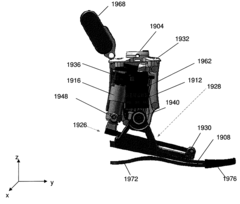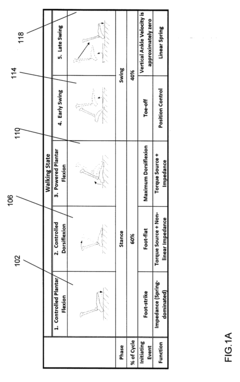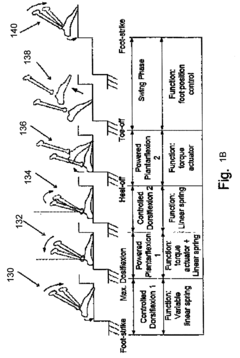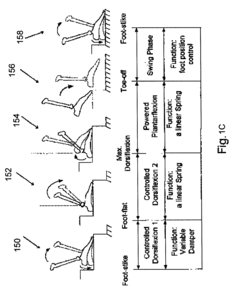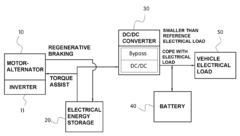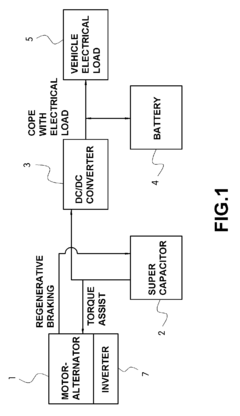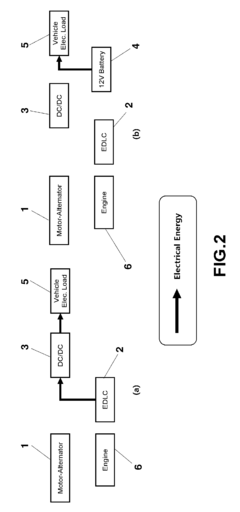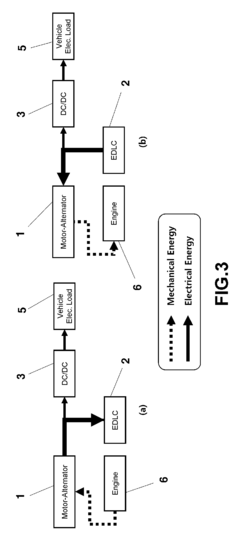Enhancements in mild hybrid systems for extreme terrain explorations
AUG 18, 202510 MIN READ
Generate Your Research Report Instantly with AI Agent
Patsnap Eureka helps you evaluate technical feasibility & market potential.
Mild Hybrid Evolution and Objectives
Mild hybrid systems have undergone significant evolution since their inception, driven by the need for improved fuel efficiency and reduced emissions in automotive applications. Initially developed for conventional on-road vehicles, these systems have gradually expanded their capabilities to address more challenging environments, including extreme terrain exploration.
The evolution of mild hybrid systems for extreme terrain applications began with the adaptation of existing technologies used in passenger vehicles. Early systems focused on basic start-stop functionality and regenerative braking, providing modest improvements in fuel economy. As the demand for more robust and capable exploration vehicles grew, manufacturers began to develop specialized mild hybrid solutions tailored to the unique requirements of extreme terrain operations.
One of the key evolutionary steps was the integration of more powerful electric motors and higher-capacity batteries. This allowed for increased electric assist during acceleration and climbing, crucial for navigating steep inclines and rough terrain. Additionally, advanced power management systems were developed to optimize the balance between the internal combustion engine and electric motor, ensuring efficient operation across a wide range of challenging conditions.
Another significant advancement was the implementation of intelligent torque distribution systems. These systems utilize the electric motor to precisely control power delivery to individual wheels, enhancing traction and stability in low-grip situations commonly encountered in extreme terrain exploration. This capability has greatly improved the overall performance and safety of exploration vehicles in demanding environments.
The objectives of enhancing mild hybrid systems for extreme terrain exploration are multifaceted. Primarily, these enhancements aim to extend the operational range and capabilities of exploration vehicles while minimizing their environmental impact. By leveraging the benefits of hybrid technology, researchers and manufacturers seek to develop vehicles that can traverse longer distances and tackle more challenging terrains with reduced fuel consumption and emissions.
Furthermore, the integration of mild hybrid systems in extreme terrain vehicles aims to improve overall vehicle reliability and durability. The reduced stress on mechanical components, achieved through electric assist and intelligent power management, can potentially extend the lifespan of critical drivetrain components, reducing maintenance requirements and increasing mission success rates in remote and hostile environments.
Another key objective is to enhance the versatility of exploration vehicles. Advanced mild hybrid systems can provide auxiliary power for scientific equipment and support systems, eliminating the need for separate generators and reducing the overall weight and complexity of the vehicle. This integration of power systems can significantly expand the range of research and exploration activities that can be conducted in extreme environments.
As the technology continues to evolve, future objectives include the development of more advanced energy recovery systems, capable of harvesting energy from vehicle suspension movements and thermal gradients encountered in extreme environments. Additionally, there is a growing focus on the integration of artificial intelligence and machine learning algorithms to further optimize hybrid system performance based on real-time terrain analysis and mission parameters.
The evolution of mild hybrid systems for extreme terrain applications began with the adaptation of existing technologies used in passenger vehicles. Early systems focused on basic start-stop functionality and regenerative braking, providing modest improvements in fuel economy. As the demand for more robust and capable exploration vehicles grew, manufacturers began to develop specialized mild hybrid solutions tailored to the unique requirements of extreme terrain operations.
One of the key evolutionary steps was the integration of more powerful electric motors and higher-capacity batteries. This allowed for increased electric assist during acceleration and climbing, crucial for navigating steep inclines and rough terrain. Additionally, advanced power management systems were developed to optimize the balance between the internal combustion engine and electric motor, ensuring efficient operation across a wide range of challenging conditions.
Another significant advancement was the implementation of intelligent torque distribution systems. These systems utilize the electric motor to precisely control power delivery to individual wheels, enhancing traction and stability in low-grip situations commonly encountered in extreme terrain exploration. This capability has greatly improved the overall performance and safety of exploration vehicles in demanding environments.
The objectives of enhancing mild hybrid systems for extreme terrain exploration are multifaceted. Primarily, these enhancements aim to extend the operational range and capabilities of exploration vehicles while minimizing their environmental impact. By leveraging the benefits of hybrid technology, researchers and manufacturers seek to develop vehicles that can traverse longer distances and tackle more challenging terrains with reduced fuel consumption and emissions.
Furthermore, the integration of mild hybrid systems in extreme terrain vehicles aims to improve overall vehicle reliability and durability. The reduced stress on mechanical components, achieved through electric assist and intelligent power management, can potentially extend the lifespan of critical drivetrain components, reducing maintenance requirements and increasing mission success rates in remote and hostile environments.
Another key objective is to enhance the versatility of exploration vehicles. Advanced mild hybrid systems can provide auxiliary power for scientific equipment and support systems, eliminating the need for separate generators and reducing the overall weight and complexity of the vehicle. This integration of power systems can significantly expand the range of research and exploration activities that can be conducted in extreme environments.
As the technology continues to evolve, future objectives include the development of more advanced energy recovery systems, capable of harvesting energy from vehicle suspension movements and thermal gradients encountered in extreme environments. Additionally, there is a growing focus on the integration of artificial intelligence and machine learning algorithms to further optimize hybrid system performance based on real-time terrain analysis and mission parameters.
Market Analysis for Extreme Terrain Vehicles
The market for extreme terrain vehicles has been experiencing significant growth in recent years, driven by increasing demand from various sectors including military, exploration, scientific research, and adventure tourism. This growth is particularly notable in regions with challenging landscapes such as arctic tundra, deserts, mountainous areas, and dense forests.
The global extreme terrain vehicle market was valued at approximately $2.5 billion in 2020 and is projected to reach $3.9 billion by 2025, growing at a CAGR of 9.3% during the forecast period. This growth is attributed to the rising need for vehicles capable of navigating harsh environments for both commercial and military applications.
Military and defense sectors remain the largest consumers of extreme terrain vehicles, accounting for about 40% of the market share. These vehicles are crucial for border patrol, reconnaissance missions, and troop transport in difficult terrains. The scientific research sector is also a significant contributor, with an increasing number of expeditions to remote areas for climate studies, geological surveys, and wildlife research.
The adventure tourism industry has emerged as a rapidly growing segment within the extreme terrain vehicle market. As more travelers seek unique experiences in remote locations, the demand for rugged, all-terrain vehicles has surged. This trend is particularly evident in countries with diverse landscapes such as Canada, Australia, and Iceland.
In terms of regional distribution, North America currently holds the largest market share at 35%, followed by Europe at 28% and Asia-Pacific at 22%. The Middle East and Africa region is expected to show the fastest growth rate in the coming years due to increasing military modernization programs and growing interest in desert tourism.
The market is characterized by a high degree of technological innovation, with manufacturers focusing on developing more efficient, environmentally friendly, and versatile vehicles. The integration of mild hybrid systems in extreme terrain vehicles is a key trend, addressing the need for improved fuel efficiency and reduced emissions without compromising on performance in challenging conditions.
Customer preferences are shifting towards vehicles with enhanced safety features, better fuel economy, and advanced navigation systems. There is also a growing demand for electric and hybrid extreme terrain vehicles, driven by stringent environmental regulations and the push for sustainable exploration practices.
The competitive landscape of the extreme terrain vehicle market is moderately fragmented, with a mix of established players and new entrants. Key market players are investing heavily in R&D to develop innovative solutions and gain a competitive edge. Strategic partnerships and collaborations between vehicle manufacturers and technology providers are becoming increasingly common to accelerate the development of next-generation extreme terrain vehicles.
The global extreme terrain vehicle market was valued at approximately $2.5 billion in 2020 and is projected to reach $3.9 billion by 2025, growing at a CAGR of 9.3% during the forecast period. This growth is attributed to the rising need for vehicles capable of navigating harsh environments for both commercial and military applications.
Military and defense sectors remain the largest consumers of extreme terrain vehicles, accounting for about 40% of the market share. These vehicles are crucial for border patrol, reconnaissance missions, and troop transport in difficult terrains. The scientific research sector is also a significant contributor, with an increasing number of expeditions to remote areas for climate studies, geological surveys, and wildlife research.
The adventure tourism industry has emerged as a rapidly growing segment within the extreme terrain vehicle market. As more travelers seek unique experiences in remote locations, the demand for rugged, all-terrain vehicles has surged. This trend is particularly evident in countries with diverse landscapes such as Canada, Australia, and Iceland.
In terms of regional distribution, North America currently holds the largest market share at 35%, followed by Europe at 28% and Asia-Pacific at 22%. The Middle East and Africa region is expected to show the fastest growth rate in the coming years due to increasing military modernization programs and growing interest in desert tourism.
The market is characterized by a high degree of technological innovation, with manufacturers focusing on developing more efficient, environmentally friendly, and versatile vehicles. The integration of mild hybrid systems in extreme terrain vehicles is a key trend, addressing the need for improved fuel efficiency and reduced emissions without compromising on performance in challenging conditions.
Customer preferences are shifting towards vehicles with enhanced safety features, better fuel economy, and advanced navigation systems. There is also a growing demand for electric and hybrid extreme terrain vehicles, driven by stringent environmental regulations and the push for sustainable exploration practices.
The competitive landscape of the extreme terrain vehicle market is moderately fragmented, with a mix of established players and new entrants. Key market players are investing heavily in R&D to develop innovative solutions and gain a competitive edge. Strategic partnerships and collaborations between vehicle manufacturers and technology providers are becoming increasingly common to accelerate the development of next-generation extreme terrain vehicles.
Current Mild Hybrid Challenges in Harsh Environments
Mild hybrid systems face significant challenges when operating in extreme terrain and harsh environments. The primary issue is the system's ability to maintain optimal performance and efficiency under severe conditions. Extreme temperatures, both hot and cold, can significantly impact battery performance and longevity. In cold environments, battery capacity decreases, reducing the system's overall effectiveness. Conversely, high temperatures can accelerate battery degradation and potentially lead to thermal runaway.
Terrain-induced vibrations and shocks pose another major challenge. The constant jarring and impacts experienced during off-road exploration can damage sensitive electronic components and connections within the mild hybrid system. This not only affects the system's reliability but also increases the risk of failure during critical operations. Additionally, the increased stress on mechanical components, such as the electric motor and its integration with the internal combustion engine, can lead to premature wear and reduced efficiency.
Dust, mud, and water ingress present significant obstacles for mild hybrid systems in extreme environments. These elements can interfere with cooling systems, potentially causing overheating issues for both the electric components and the internal combustion engine. Furthermore, moisture and contaminants can compromise electrical connections, leading to short circuits or corrosion over time. This necessitates robust sealing and protection measures, which can add weight and complexity to the system.
The regenerative braking system, a key feature of mild hybrid technology, faces unique challenges in extreme terrain. Uneven surfaces and sudden changes in traction can reduce the effectiveness of energy recovery, limiting the system's ability to recharge the battery efficiently. This is particularly problematic in extended off-road scenarios where opportunities for conventional charging may be limited.
Power management and distribution become more complex in harsh environments. The system must be able to quickly adapt to rapidly changing conditions, balancing power output between the electric motor and internal combustion engine to maintain vehicle performance and stability. This requires sophisticated control algorithms capable of processing multiple environmental and vehicle parameters in real-time.
Lastly, the weight and packaging constraints of exploration vehicles present a significant challenge for mild hybrid systems. The additional components required for harsh environment operation, such as reinforced casings and enhanced cooling systems, can increase the overall weight and space requirements of the hybrid system. This can potentially offset some of the efficiency gains and impact the vehicle's payload capacity, crucial factors in extreme terrain exploration.
Terrain-induced vibrations and shocks pose another major challenge. The constant jarring and impacts experienced during off-road exploration can damage sensitive electronic components and connections within the mild hybrid system. This not only affects the system's reliability but also increases the risk of failure during critical operations. Additionally, the increased stress on mechanical components, such as the electric motor and its integration with the internal combustion engine, can lead to premature wear and reduced efficiency.
Dust, mud, and water ingress present significant obstacles for mild hybrid systems in extreme environments. These elements can interfere with cooling systems, potentially causing overheating issues for both the electric components and the internal combustion engine. Furthermore, moisture and contaminants can compromise electrical connections, leading to short circuits or corrosion over time. This necessitates robust sealing and protection measures, which can add weight and complexity to the system.
The regenerative braking system, a key feature of mild hybrid technology, faces unique challenges in extreme terrain. Uneven surfaces and sudden changes in traction can reduce the effectiveness of energy recovery, limiting the system's ability to recharge the battery efficiently. This is particularly problematic in extended off-road scenarios where opportunities for conventional charging may be limited.
Power management and distribution become more complex in harsh environments. The system must be able to quickly adapt to rapidly changing conditions, balancing power output between the electric motor and internal combustion engine to maintain vehicle performance and stability. This requires sophisticated control algorithms capable of processing multiple environmental and vehicle parameters in real-time.
Lastly, the weight and packaging constraints of exploration vehicles present a significant challenge for mild hybrid systems. The additional components required for harsh environment operation, such as reinforced casings and enhanced cooling systems, can increase the overall weight and space requirements of the hybrid system. This can potentially offset some of the efficiency gains and impact the vehicle's payload capacity, crucial factors in extreme terrain exploration.
Existing Mild Hybrid Solutions for Rugged Conditions
01 Electric motor integration in mild hybrid systems
Mild hybrid systems incorporate electric motors to assist the internal combustion engine, improving fuel efficiency and reducing emissions. These motors can provide additional power during acceleration, enable start-stop functionality, and recover energy through regenerative braking. The integration of electric motors in mild hybrid systems allows for a balance between conventional and electric propulsion.- Mild hybrid system architecture: Mild hybrid systems typically consist of an internal combustion engine, an electric motor/generator, and a battery. The electric motor assists the engine during acceleration and can recover energy during braking. This architecture allows for improved fuel efficiency and reduced emissions without the complexity of full hybrid systems.
- Energy management and control strategies: Advanced control strategies are employed in mild hybrid systems to optimize energy flow between the engine, electric motor, and battery. These strategies include intelligent power distribution, regenerative braking, and start-stop functionality, which contribute to improved overall system efficiency and performance.
- Integration with transmission systems: Mild hybrid systems can be integrated with various transmission types, including manual, automatic, and continuously variable transmissions (CVT). The integration allows for seamless power blending between the electric motor and the internal combustion engine, enhancing drivability and efficiency.
- Battery and power electronics: Mild hybrid systems utilize specialized batteries and power electronics to manage the flow of electrical energy. These components are designed to handle frequent charge-discharge cycles and provide rapid power delivery to support the electric motor's assist function.
- Vehicle integration and packaging: The integration of mild hybrid components into existing vehicle platforms requires careful consideration of packaging constraints. Innovative solutions are developed to accommodate the additional components while minimizing impact on vehicle weight, interior space, and overall design.
02 Battery management and power distribution
Efficient battery management and power distribution are crucial in mild hybrid systems. This includes optimizing the charging and discharging of the battery, managing power flow between the electric motor and internal combustion engine, and ensuring proper voltage regulation. Advanced control strategies are employed to maximize energy efficiency and system performance.Expand Specific Solutions03 Transmission and drivetrain optimization
Mild hybrid systems often require specialized transmissions and drivetrain components to effectively integrate the electric motor with the internal combustion engine. This may include the use of dual-clutch systems, continuously variable transmissions, or modified gearboxes to accommodate the hybrid powertrain. Optimizing these components enhances overall system efficiency and performance.Expand Specific Solutions04 Control strategies for hybrid operation
Sophisticated control strategies are implemented in mild hybrid systems to manage the interaction between the electric motor and internal combustion engine. These strategies optimize power delivery, fuel consumption, and emissions reduction based on driving conditions and vehicle demands. Advanced algorithms and sensors are used to determine the most efficient operating mode at any given time.Expand Specific Solutions05 Thermal management in mild hybrid systems
Effective thermal management is essential in mild hybrid systems to maintain optimal operating temperatures for both the electric components and the internal combustion engine. This includes cooling systems for the battery, electric motor, and power electronics, as well as strategies to utilize waste heat for improving overall system efficiency.Expand Specific Solutions
Key Players in Extreme Terrain Hybrid Systems
The development of mild hybrid systems for extreme terrain exploration is in a nascent stage, with significant potential for growth. The market size is relatively small but expanding as demand increases for more efficient and capable vehicles in challenging environments. Technologically, the field is evolving rapidly, with companies like BYD, Hyundai, and BMW leading innovation. Universities such as Shandong University and Beihang University are contributing to research advancements. The competitive landscape is diverse, including traditional automakers, emerging electric vehicle manufacturers, and specialized engineering firms, all vying to develop robust solutions for extreme terrain applications.
BYD Co., Ltd.
Technical Solution: BYD has developed an advanced mild hybrid system specifically designed for extreme terrain exploration. Their system integrates a high-efficiency internal combustion engine with a powerful electric motor, utilizing a 48V architecture. The system incorporates regenerative braking technology that is optimized for steep descents and rough terrain, capturing and storing energy that would otherwise be lost. BYD's mild hybrid system also features an intelligent power management system that dynamically adjusts the power distribution between the combustion engine and electric motor based on real-time terrain conditions and vehicle load[1]. This system is capable of providing instant torque boost for overcoming obstacles and navigating challenging terrains, while also improving fuel efficiency by up to 20% compared to conventional powertrains in extreme conditions[2].
Strengths: Excellent energy recovery in challenging terrains, significant fuel efficiency improvements, and adaptive power management. Weaknesses: Potentially higher initial cost and complexity compared to traditional systems.
Bayerische Motoren Werke AG
Technical Solution: BMW has engineered a sophisticated mild hybrid system tailored for extreme terrain exploration vehicles. Their system employs a 48V electrical architecture combined with a compact yet powerful electric motor integrated into the transmission. This setup allows for seamless power assistance and energy recuperation. BMW's system features an advanced terrain recognition algorithm that predicts upcoming terrain challenges and pre-emptively adjusts the hybrid system's operation[3]. The system also incorporates a high-capacity lithium-ion battery specially designed to withstand extreme temperatures and vibrations encountered in harsh environments. BMW's mild hybrid technology for extreme terrain includes an innovative "rock crawling" mode, which provides precise torque control for navigating over large obstacles, and a "sand mode" that optimizes power delivery for loose surfaces[4]. These specialized modes work in conjunction with the vehicle's suspension and traction control systems to enhance overall performance and efficiency in challenging conditions.
Strengths: Highly specialized terrain modes, predictive terrain adaptation, and robust battery design for extreme conditions. Weaknesses: Potentially limited to premium vehicle segments due to high technology costs.
Core Innovations in Extreme Environment Hybridization
Hybrid Terrain-Adaptive Lower-Extremity Systems
PatentActiveUS20100179668A1
Innovation
- The development of dynamic lower-extremity prosthetic, orthotic, and exoskeleton systems that detect terrain and adapt by optimizing mechanical characteristics and controlling actuators based on activity, terrain texture, and user parameters, using inertial measurement units and sensors to adjust impedance and torque in real-time, allowing for terrain-adaptive behavior.
Mild hybrid system and method for controlling the same
PatentActiveUS9428063B2
Innovation
- A mild hybrid system utilizing a unidirectional DC/DC buck converter with a bypass function to manage electrical energy flow, allowing for bidirectional electricity flow in bypass states and eliminating the need for a bidirectional converter.
Environmental Impact Assessment
The environmental impact assessment of enhancements in mild hybrid systems for extreme terrain explorations is a critical aspect of technological advancement in this field. These systems, designed to operate in challenging and often pristine environments, must be evaluated for their potential effects on ecosystems and biodiversity.
Mild hybrid systems in extreme terrain vehicles typically incorporate electric motors and batteries alongside traditional combustion engines. This combination aims to reduce fuel consumption and emissions while providing the necessary power for navigating difficult landscapes. However, the introduction of these systems into sensitive environments raises several environmental concerns.
One primary consideration is the reduction of greenhouse gas emissions. Mild hybrid systems can significantly decrease carbon dioxide output compared to conventional vehicles, potentially mitigating the impact of exploration activities on global climate change. This is particularly important in polar regions and other areas highly susceptible to climate shifts.
The noise pollution generated by exploration vehicles is another crucial factor. Mild hybrid systems often operate more quietly than traditional engines, especially at low speeds or when using electric-only mode. This reduced noise can minimize disturbance to wildlife, particularly in areas where animals are sensitive to acoustic disruptions.
However, the production and disposal of batteries used in mild hybrid systems present environmental challenges. The mining of rare earth elements and other materials for battery production can have significant ecological impacts. Additionally, the proper recycling and disposal of these batteries at the end of their lifecycle is essential to prevent soil and water contamination in extreme terrain environments.
The potential for oil or fuel spills is reduced with mild hybrid systems, as they typically require less fuel overall. This decreased risk is particularly beneficial in fragile ecosystems where spills could have devastating and long-lasting effects on flora and fauna.
Electromagnetic emissions from hybrid systems must also be considered, especially in areas where they might interfere with wildlife navigation or communication. While generally low, these emissions could potentially affect sensitive species in extreme environments.
The physical footprint of vehicles equipped with mild hybrid systems is another aspect to assess. If these systems allow for smaller, lighter vehicles without compromising performance, they could reduce soil compaction and vegetation damage in extreme terrains.
In conclusion, while mild hybrid systems offer several environmental benefits for extreme terrain exploration, a comprehensive assessment must consider both positive and negative impacts. Balancing improved efficiency and reduced emissions against potential risks associated with battery production and disposal is crucial for sustainable exploration practices in sensitive ecosystems.
Mild hybrid systems in extreme terrain vehicles typically incorporate electric motors and batteries alongside traditional combustion engines. This combination aims to reduce fuel consumption and emissions while providing the necessary power for navigating difficult landscapes. However, the introduction of these systems into sensitive environments raises several environmental concerns.
One primary consideration is the reduction of greenhouse gas emissions. Mild hybrid systems can significantly decrease carbon dioxide output compared to conventional vehicles, potentially mitigating the impact of exploration activities on global climate change. This is particularly important in polar regions and other areas highly susceptible to climate shifts.
The noise pollution generated by exploration vehicles is another crucial factor. Mild hybrid systems often operate more quietly than traditional engines, especially at low speeds or when using electric-only mode. This reduced noise can minimize disturbance to wildlife, particularly in areas where animals are sensitive to acoustic disruptions.
However, the production and disposal of batteries used in mild hybrid systems present environmental challenges. The mining of rare earth elements and other materials for battery production can have significant ecological impacts. Additionally, the proper recycling and disposal of these batteries at the end of their lifecycle is essential to prevent soil and water contamination in extreme terrain environments.
The potential for oil or fuel spills is reduced with mild hybrid systems, as they typically require less fuel overall. This decreased risk is particularly beneficial in fragile ecosystems where spills could have devastating and long-lasting effects on flora and fauna.
Electromagnetic emissions from hybrid systems must also be considered, especially in areas where they might interfere with wildlife navigation or communication. While generally low, these emissions could potentially affect sensitive species in extreme environments.
The physical footprint of vehicles equipped with mild hybrid systems is another aspect to assess. If these systems allow for smaller, lighter vehicles without compromising performance, they could reduce soil compaction and vegetation damage in extreme terrains.
In conclusion, while mild hybrid systems offer several environmental benefits for extreme terrain exploration, a comprehensive assessment must consider both positive and negative impacts. Balancing improved efficiency and reduced emissions against potential risks associated with battery production and disposal is crucial for sustainable exploration practices in sensitive ecosystems.
Safety and Reliability Considerations
Safety and reliability are paramount considerations in the development and implementation of mild hybrid systems for extreme terrain explorations. These systems must operate flawlessly in harsh environments, ensuring the safety of personnel and equipment while maintaining mission integrity.
One of the primary safety concerns in extreme terrain exploration is the risk of system failure in remote locations. Mild hybrid systems must incorporate robust fail-safe mechanisms and redundancies to mitigate potential hazards. This includes implementing advanced diagnostic systems that can detect and isolate faults before they escalate into critical issues. Additionally, the integration of intelligent power management systems can help prevent overloading and ensure optimal performance under varying conditions.
Reliability in extreme environments necessitates the use of ruggedized components capable of withstanding extreme temperatures, humidity, vibration, and shock. Materials selection plays a crucial role in this aspect, with a focus on corrosion-resistant alloys and high-performance polymers that can maintain their structural integrity under harsh conditions. Furthermore, advanced sealing technologies are essential to protect sensitive electronic components from dust, moisture, and other environmental contaminants.
The electrical systems in mild hybrid vehicles for extreme terrain exploration require special attention to safety. High-voltage components must be properly insulated and protected against short circuits and electrical arcing. Implementing sophisticated battery management systems is crucial to monitor cell temperatures, prevent overcharging, and manage thermal runaway risks. Additionally, the integration of rapid disconnect systems can quickly isolate the high-voltage system in the event of a collision or system failure.
Reliability testing for these systems must go beyond standard automotive protocols. Accelerated life testing under simulated extreme conditions, including thermal cycling, vibration testing, and submersion tests, should be conducted to validate system durability. Long-term field trials in actual extreme environments are also essential to identify and address unforeseen challenges that may not be apparent in laboratory settings.
Human factors engineering plays a significant role in ensuring the safe operation of mild hybrid systems in extreme terrains. User interfaces must be designed for ease of use even in high-stress situations, with clear and intuitive controls. Training programs for operators should be comprehensive, covering not only normal operation but also emergency procedures and troubleshooting techniques.
Lastly, the development of robust maintenance protocols is crucial for long-term reliability. This includes the implementation of predictive maintenance strategies using real-time data analytics to anticipate potential failures before they occur. Remote diagnostics capabilities can also enable expert support even in isolated locations, enhancing the overall safety and reliability of the system.
One of the primary safety concerns in extreme terrain exploration is the risk of system failure in remote locations. Mild hybrid systems must incorporate robust fail-safe mechanisms and redundancies to mitigate potential hazards. This includes implementing advanced diagnostic systems that can detect and isolate faults before they escalate into critical issues. Additionally, the integration of intelligent power management systems can help prevent overloading and ensure optimal performance under varying conditions.
Reliability in extreme environments necessitates the use of ruggedized components capable of withstanding extreme temperatures, humidity, vibration, and shock. Materials selection plays a crucial role in this aspect, with a focus on corrosion-resistant alloys and high-performance polymers that can maintain their structural integrity under harsh conditions. Furthermore, advanced sealing technologies are essential to protect sensitive electronic components from dust, moisture, and other environmental contaminants.
The electrical systems in mild hybrid vehicles for extreme terrain exploration require special attention to safety. High-voltage components must be properly insulated and protected against short circuits and electrical arcing. Implementing sophisticated battery management systems is crucial to monitor cell temperatures, prevent overcharging, and manage thermal runaway risks. Additionally, the integration of rapid disconnect systems can quickly isolate the high-voltage system in the event of a collision or system failure.
Reliability testing for these systems must go beyond standard automotive protocols. Accelerated life testing under simulated extreme conditions, including thermal cycling, vibration testing, and submersion tests, should be conducted to validate system durability. Long-term field trials in actual extreme environments are also essential to identify and address unforeseen challenges that may not be apparent in laboratory settings.
Human factors engineering plays a significant role in ensuring the safe operation of mild hybrid systems in extreme terrains. User interfaces must be designed for ease of use even in high-stress situations, with clear and intuitive controls. Training programs for operators should be comprehensive, covering not only normal operation but also emergency procedures and troubleshooting techniques.
Lastly, the development of robust maintenance protocols is crucial for long-term reliability. This includes the implementation of predictive maintenance strategies using real-time data analytics to anticipate potential failures before they occur. Remote diagnostics capabilities can also enable expert support even in isolated locations, enhancing the overall safety and reliability of the system.
Unlock deeper insights with Patsnap Eureka Quick Research — get a full tech report to explore trends and direct your research. Try now!
Generate Your Research Report Instantly with AI Agent
Supercharge your innovation with Patsnap Eureka AI Agent Platform!
